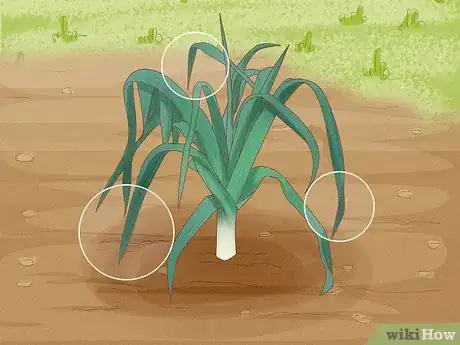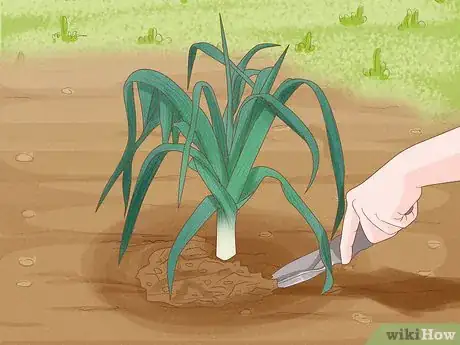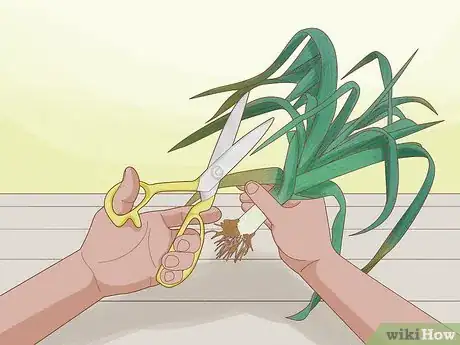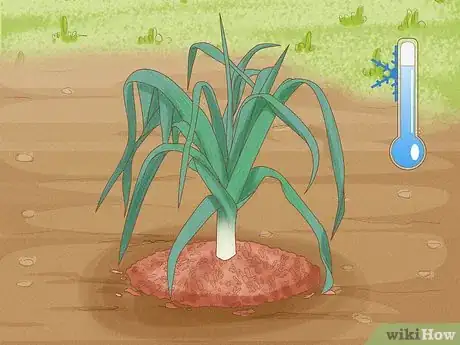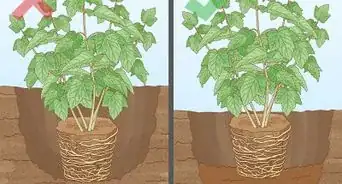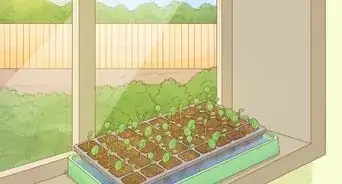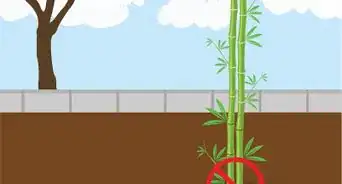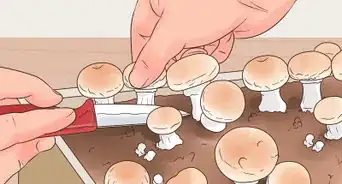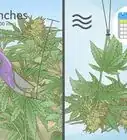This article was co-authored by Ben Barkan and by wikiHow staff writer, Hunter Rising. Ben Barkan is a Garden and Landscape Designer and the Owner and Founder of HomeHarvest LLC, an edible landscapes and construction business based in Boston, Massachusetts. Ben has over 12 years of experience working with organic gardening and specializes in designing and building beautiful landscapes with custom construction and creative plant integration. He is a Certified Permaculture Designer, is licensed Construction Supervisor in Massachusetts, and is a Licensed Home Improvement Contractor. He holds an associates degree in Sustainable Agriculture from the University of Massachusetts Amherst.
There are 8 references cited in this article, which can be found at the bottom of the page.
This article has been viewed 11,366 times.
So you planted some delicious leeks in your garden and are excited to cook with them, but how can you tell when they’re ready to use? Luckily, there are a few sure signs to look for around harvest time. We know you have a few questions about digging up and storing your leeks, so just keep reading for all the answers you need!
Steps
What do leeks look like when they’re ready to harvest?
-
1The top leaves will have a dark-blue color. Check the leafy growth at the top of the leek stalk to see if it has a darker color. If the leaves still look light green, then your leeks are still growing, so just leave them in the ground.[1]
-
2The white stalk should feel firm and be 3 in (7.6 cm) tall. The edible part of a leek is the white part of the stalk near the bottom. Squeeze the stalk to check that it feels firm rather than mushy. Once the white section grows 3 inches (7.6 cm) up from the ground, you’re ready to harvest your leeks![2]Advertisement
-
3Leek stalks should be at least 1 in (2.5 cm) in diameter. That’s about the same size as a quarter. Check your leeks near the end of their growing season to see if they’re the right size. If your leeks are any smaller, let them fill in before you start your harvest.[3]
- It’s okay for your leeks to grow larger than 1 inch (2.5 cm) in diameter if you want larger plants.
How do you pull leeks out of the ground?
-
1Dig around the leek with a trowel to loosen the soil. Push your trowel into the soil a few inches out from your leek stalk, and break apart the soil. Work the trowel around the leek in a circle until you can easily move and pull the leek out.[5]
-
2Twist and pull the leek out of the soil. Firmly grab the base of the leek and give it a slight twist to get the roots out of the ground. You should be able to easily lift the leek straight out of the soil after that. If you can’t, loosen the soil with your trowel a little bit more.[6]
-
3Trim the roots and any dead leaves right away. If there are any yellow or wilted leaves on the leek, simply pull them off by hand. Be sure to leave the healthy leaves attached to the stalk for now. Then, use a pair of garden scissors or a knife to cut the roots off at the base of the leek stalk.[7]
How do you prepare leeks for storage?
-
1Wrap leeks in plastic wrap before putting them in your fridge. Leeks may give off an odor that other foods in your fridge might absorb. Leave your leeks whole until you’re ready to cook them. Put a layer of plastic wrap around the entire leek stalk to keep odors locked away. You can keep fresh leeks in your fridge for up to 2 weeks.[10]
-
2Cut and clean the leeks before cooking them. Some soil can easily get caught between the leaves of leeks, so always wash them. Slice the whole leek lengthwise and separate the layers of leaves. Rinse the leaves underneath cool running water to remove any leftover dirt.[11]
How do you store leeks in the freezer?
-
1Clean and trim your leeks first. Start by making a vertical slit down the length of the entire stalk. Trim off the dark green leaves on top and get rid of them since they aren’t edible. Peel all the outer layers on the remaining part of the stalk until you reach the tender parts underneath. From there, you can chop the leeks to whatever size you want before rinsing them in cold water.[12]
-
2Blanch your leeks in boiling water to preserve their flavor. Blanching can help your leeks maintain their texture and flavor for longer. Fill a pot with some water and bring it to a boil. Toss in your leeks and let them boil for 2–3 minutes before taking them out to cool and patting them dry with a towel.[13]
-
3
How do you store leeks long term?
-
1Leave leeks in the ground with mulch to preserve them through mild winters. Since leaks will go bad more quickly after harvesting them, leave them in the ground if you can. When colder weather starts coming in, build a hill around the leek stalk with soil and mulch to protect it. Many leeks are safe in temperatures as low as 20 °F (−7 °C).[17]
- Be sure to harvest leeks if the soil is about to freeze solid.
-
2Dry chopped leeks to use in soups and sauces. Dried leeks retain their flavor and nutrients the best long-term. If you want to have dried leeks to sprinkle onto your recipes, wash and cut your leeks into 1⁄4 in (0.64 cm) slices. Place them on a tray in a single layer and put them in your oven at 145 °F (63 °C) until they’re crisp.[18]
Warnings
- Avoid using any leeks that have dry or discolored leaves since those could be signs of disease or damage.[20]⧼thumbs_response⧽
References
- ↑ https://extension.umn.edu/vegetables/growing-leeks
- ↑ https://extension.umn.edu/vegetables/growing-leeks
- ↑ https://extension.umd.edu/resource/leeks
- ↑ https://hort.extension.wisc.edu/articles/leeks/
- ↑ https://extension.umn.edu/vegetables/growing-leeks
- ↑ https://extension.umn.edu/vegetables/growing-leeks
- ↑ https://hort.extension.wisc.edu/articles/leeks/
- ↑ https://hort.extension.wisc.edu/articles/leeks/
- ↑ https://extension.psu.edu/season-extenders-and-growing-fall-vegetables
- ↑ https://www.canr.msu.edu/uploads/resources/pdfs/leeks_(hni51).pdf
- ↑ https://extension.umn.edu/vegetables/growing-leeks
- ↑ https://www.epicurious.com/expert-advice/how-to-clean-leeks-like-a-pro-article
- ↑ https://extension.usu.edu/yardandgarden/research/leeks-in-the-garden
- ↑ https://extension.usu.edu/yardandgarden/research/leeks-in-the-garden
- ↑ https://ohioline.osu.edu/factsheet/HYG-5333
- ↑ https://www.canr.msu.edu/uploads/resources/pdfs/leeks_(hni51).pdf
- ↑ https://hort.extension.wisc.edu/articles/leeks/
- ↑ https://www.canr.msu.edu/uploads/resources/pdfs/leeks_(hni51).pdf
- ↑ https://extension.umn.edu/vegetables/growing-leeks
- ↑ https://www.canr.msu.edu/uploads/resources/pdfs/leeks_(hni51).pdf
